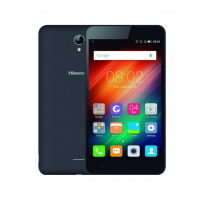
Do you have a question about the Hisense F20 and is the answer not in the manual?
| Display diagonal | 5.5 \ |
|---|---|
| Display resolution | 1280 x 720 pixels |
| Display number of colors | 16.78 million colors |
| Processor cores | 4 |
| Processor family | Qualcomm Snapdragon |
| Processor frequency | 1.1 GHz |
| RAM capacity | 1 GB |
| Compatible memory cards | MicroSD (TransFlash) |
| Maximum memory card size | 32 GB |
| Internal storage capacity | 8 GB |
| Front camera type | Single camera |
| Video recording modes | 1080p |
| Rear camera resolution (numeric) | 8 MP |
| Front camera resolution (numeric) | 2 MP |
| 4G standard | LTE |
| 2G standards | GSM |
| 3G standards | WCDMA |
| SIM card type | MicroSIM |
| Wi-Fi standards | 802.11b, 802.11g, Wi-Fi 4 (802.11n) |
| Bluetooth version | 4.0 |
| SIM card capability | Dual SIM |
| Mobile network generation | 4G |
| USB version | 2.0 |
| USB connector type | Micro-USB |
| HDMI ports quantity | 0 |
| Headphone connectivity | 3.5 mm |
| Form factor | Bar |
| Product color | White |
| Platform | Android |
| App distribution platform | Google Play |
| Operating system installed | Android 5.1 |
| Subscription type | - |
| Audio formats supported | AAC, MIDI, MP3 |
| Image formats supported | BMP, JPG, PNG |
| Video formats supported | 3G2, 3GP, MP4 |
| Multimedia Messaging Service (MMS) | Multimedia Messaging Service (MMS) is a standard way to send messages that include multimedia content to and from a mobile phone over a cellular network |
| Talk time (2G) | - h |
| Battery capacity | 2500 mAh |
| Video call | No |
| Personal info management (PIM) | Alarm clock, Calculator, Calendar, Notes, Recorder |
| Storage temperature (T-T) | -40 - 70 °C |
| Operating temperature (T-T) | 20 - 60 °C |
| Operating relative humidity (H-H) | 5 - 95 % |
| Cables included | Audio (3.5mm) |
| Depth | 9.65 mm |
|---|---|
| Width | 77 mm |
| Height | 153.6 mm |
| Weight | - g |
Precautions for using the phone near medical devices like pacemakers to avoid interference.
Guidelines for safe mobile phone use while driving to prevent accidents.
Identifies external phone components and explains the function of each key.
Explains the Home screen as the starting point and details its components like Status Bar, Widgets, and Icons.
Details the steps for charging the battery and factors affecting charging duration, including important notes.
Instructions on how to power the phone on and off, including a note for low battery.
Guide for configuring the phone upon first startup, including language, network connection, and screen lock.
Explains the Home screen as the starting point for applications and functions, detailing its components.
Describes how notifications alert users to new messages and events.
Instructions on how to open the notifications panel by swiping down the status bar.
Guide on adding and removing items like wallpapers and widgets from the Home screen.
How to view and switch between recently used applications.
Step-by-step guide for initiating, receiving, and managing calls, including call options.
Instructions on how to create and send text messages.
Guide on how to add new contacts to the phone or SIM card.
How to access and use the music application to play audio files.
Instructions for taking photos and recording videos with the phone's camera.
Guide on connecting to the web and using the Chrome browser for internet access.
Steps to connect the phone to a Wi-Fi network, including password entry.
Information on how phone usage, especially internet, can generate charges and recommendations for managing them.
Notes on using non-original accessories, potential differences in specifications, and carrier-specific functions.
Solutions for SIM card errors and no network connection or dropped network issues.
Troubleshooting steps for incorrect security codes and unavailable calls.
Resolving problems with the phone not switching on or encountering charge errors.
Fixes for problems with sending/receiving messages, file formats, and screen behavior during calls.
Solutions for no sound, vibration/silent mode issues, and phone freezing or hanging.
Troubleshooting for duplicate contacts, app installation, computer connection, and call log saving.
Details compliance with FCC Rules Part 15 and measures to correct interference.
Explains the government's requirements for radio wave exposure and the phone's compliance.
